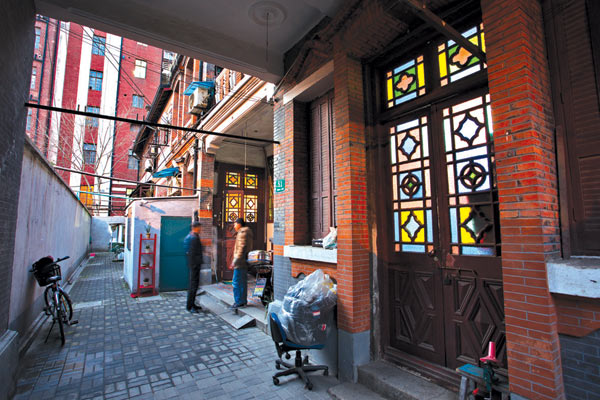Shanghai man captures his love for lane houses
Updated: 2015-07-03 10:55
By Xu Junqian in Shanghai(China Daily USA)
|
||||||||
 |
|
Retired taxi driver Shou Zhusen spends most of his spare time documenting daily life in shikumen houses through his photographs. A longtime resident of the lane houses himself, he has tied his love of photography to his fondness for the vanishing traditional homes. Shou Zhusen for China Daily |
The 61-year-old Shou Zhusen said his interest in photography, especially portrait photography, has been as instilled in him as his love for the Shanghai lane house where he has spent his entire life.
When the former taxi driver retired in 2012, it then naturally followed that he would combine the two interests into what he called "an unpaid dusklight job": taking pictures of elderly who live in the Shanghai lane houses.
Three years later, Shou, with a Nikon camera and a map of the city in his mind - drawn during his decades of taxi driving - has zigzagged along the narrow lanes of more than 1,000 neighborhoods of Shanghai lane houses, and taken hundreds of thousands of pictures of life and people there.
"The neighborhood of Shanghai lane houses is very unique in the way that, though its lanes are public spaces, they are rather hostile to strangers, making them feel like they're trespassing into one's home," said Shou.
Shou has taken portrait pictures of more than 20 elderly people in their lane house homes. Elderly people are those older than 85, according to Shou's definition.
"It's a race with the time. I have to start from the most transient," he explained. He does the shoots in their homes not only because "home is the most comfortable environment for the elderly, if not everyone", but also because the lane houses are quickly disappearing in the city's ever-ongoing facelift.
More than one-third of neighborhoods Shou has visited have been torn down, he estimated.
There are things such as television sets with glass covers (to keep dust from screens) and hot water bottles, which can only be found in lane houses, as people are likely to discard them once they move into new apartments. On the other hand, they can be found in the same room with modern gadgets like computers.
Shou remembered taking a picture of a 90-year-old woman in her home, buying stocks on her computer against the background of a set of nut-shell-colored furniture, a typical color of 1980's mass-produced furniture in China.
"It's a photo that can tell the time for every Chinese without caption," he said.
Shou now lives in a 53-square-meter space with his wife on the second floor of what is called a Shanghai new-style lane house in the city's former French Concession. The space is separated into a bedroom and a living room, with individual bathroom and kitchen.
Shou recalled that the space, at its peak from 1950's to 1980's, was shared by three generations - 11 people - including his parents, siblings and their offspring. Shou is the youngest son of a couple that emigrated from neighboring Shaoxing, Zhejiang province, during the 1930's, dubbed the golden era of Shanghai, where "gold can be found everywhere", as rumors had it.
Shou's parents did find their fortune then, by starting a textile factory with relatives. Later, with several bars of gold, they bought the three-floor lane house downtown. The house was re-distributed as the household for three families in the 1950's, as private property was not allowed.
"My son has left the house by moving into the apartment buildings with his small family. There isn't much I can do about the radical changes our city and our residences are undergoing. Recording the changes, however, for me is a form of memorial," said Shou.
xujunqian@chinadaily.com.cn
- Injured ROK tourists in intensive care
- 36 dead, 26 missing after banca capsized in C. Philippines
- Thai navy plans to buy three Chinese subs
- Mass casualties in Indonesian military plane crash
- Japan's LDP lawmaker denounces Abe's security policies
- More than 100 feared dead in Indonesian military plane crash

 Across America over the week (June 26-July 2)
Across America over the week (June 26-July 2)
 Solar-powered plane breaks solo flight record
Solar-powered plane breaks solo flight record
 A soap maker's fragrant life
A soap maker's fragrant life
 Ten photos you don't wanna miss - July 3
Ten photos you don't wanna miss - July 3
 Cooling off to escape the heat wave
Cooling off to escape the heat wave
 Top 10 best hotel booking apps for Android
Top 10 best hotel booking apps for Android
 Western Europe swelters in long-lasting heat wave
Western Europe swelters in long-lasting heat wave
 Top 10 shareholders of AIIB
Top 10 shareholders of AIIB
Most Viewed
Editor's Picks

|

|

|

|

|

|
Today's Top News
Will Alibaba, Amazon clash?
China-France ties 'benefit all'
Veteran diplomat in Havana shortlisted for ambassador
Solar-powered plane breaks solo flight record
California mulls move to 'zero-emission buses'
Move to Houston pays off with new business
IPR law acted out
Economic growth driving force for China's future mobility: Think tank
US Weekly

|

|






